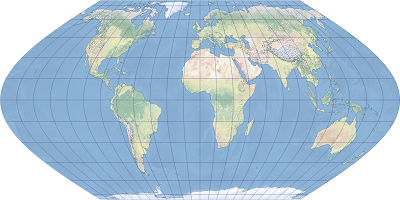Description
Eckert VI is an equal-area pseudocylindrical map projection for world maps. The meridians are sinusoidal curves, producing undesirable bulging along the equator on the western and eastern edges of the map.
The projection was introduced by Max Eckert in 1906, who preferred this projection over the more popular Eckert IV. It is available in ArcGIS Pro 1.0 and later and in ArcGIS Desktop 8.0 and later.

Projection properties
The subsections below describe the Eckert VI projection properties.
Graticule
Eckert VI is a pseudocylindric projection. The equator and the central meridian are projected as straight lines. The projected equator is about two times as long as the central meridian. The other meridians are sinusoidal curves, bulging away from the central meridian, and equally spaced. The parallels are unequally distributed straight lines perpendicular to the central meridian. The poles are straight lines half the length of equator. The graticule is symmetric across the equator and the central meridian.
Distortion
Eckert VI is an equal-area (equivalent) projection. Shapes, directions, angles, and distances are distorted and stretched north-south in tropical and midlatitude areas. Nearer the poles, features are compressed in the north-south direction. Points 49°16' north and south at the central meridian have zero distortion. The scale is correct along the 49°16' north and south parallel and constant along any given parallel. Bulging meridians produce considerable distortion toward the edge of the projection. Distortion values are symmetric across the equator and the central meridian.
Usage
The Eckert VI projection is appropriate for thematic world maps although its use is not advisable.
Variants
There are two variants available in ArcGIS. Both variants correctly support sphere-based Earth models.
- The Eckert VI variant is available in ArcGIS Pro 1.0 and later and in ArcGIS Desktop 8.0 and later. It uses the semimajor axis and spherical equations for ellipsoids.
- The Eckert VI auxiliary sphere variant is available in ArcGIS Pro 1.0 and later and in ArcGIS Desktop 9.3 and later. For ellipsoids, it uses a sphere specified by the Auxiliary Sphere Type parameter and spherical equations.
Limitations
For an ellipsoid of revolution, the equal-area property is only maintained with the Eckert VI auxiliary sphere variant when the Auxiliary Sphere Type 3 is used. Otherwise, areas are not maintained for ellipsoids.
Parameters
Eckert VI parameters are as follows:
- False Easting
- False Northing
- Central Meridian
Eckert VI auxiliary sphere parameters are as follows:
- False Easting
- False Northing
- Central Meridian
- Auxiliary Sphere Type, with values as follows:
- 0 = use semimajor axis of the geographic coordinate system
- 1 = use semiminor axis
- 2 = calculate and use authalic radius
- 3 = use authalic radius and convert geodetic latitudes to authalic latitudes
Note:
If the geographic coordinate system uses a sphere, the Auxiliary Sphere Type uses the radius of the sphere in all four cases.
Sources
Canters, F. and Decleir, H. (1989). The World in Perspective: A Directory of World Map Projections. Chichester: John Wiley and Sons.
Snyder, J. P. (1987). Map Projections: A Working Manual. U.S. Geological Survey Professional Paper 1395. Washington, DC: United States Government Printing Office.
Snyder, J. P. (1993). Flattening the Earth. Two Thousand Years of Map Projections. Chicago and London: University of Chicago Press.
Snyder, J. P. and Voxland, P. M. (1989). An Album of Map Projections. U.S. Geological Survey Professional Paper 1453. Washington, DC: United States Government Printing Office.